
By Marion Halliday, Adelaide, South Australia
Marion is “Red Nomad OZ”, author, blogger and Aussie traveller who loves discovering nature-based attractions and activities – and scenic loos – all over Australia. Her Aussie travel blog and published book “Aussie Loos with Views” provide inspiration for other Aussie explorers.
As the plane banked and descended through the last thin clouds, the island emerged. A multi-hued green jewel of an island, set in the glittering blues of the surrounding sea. Lord Howe Island was looking a lot like paradise! Now all we had to do was land.
Although the short 900 metre (2,952 feet) airstrip bisecting the island diagonally across its narrowest point was now clearly visible below, touchdown wasn’t necessarily assured. Almost constant crosswinds make the approach tricky, and planes sometimes turn back if the landing is too dangerous.
Wildlife, World Exclusives and a World Heritage Wonderland
But not today! A few minutes later I was standing on the grassy tarmac taking my first (but not last) photographs of Mounts Lidgbird and Gower, the twin peaks giving the island its distinctive silhouette.
779 km (484 miles) and a two-hour Dash-8 Turbo Prop flight from Sydney, Lord Howe Island isn’t just different from most of the rest of Australia, it’s different from most of the rest of the world. That’s not merely my personal opinion either.
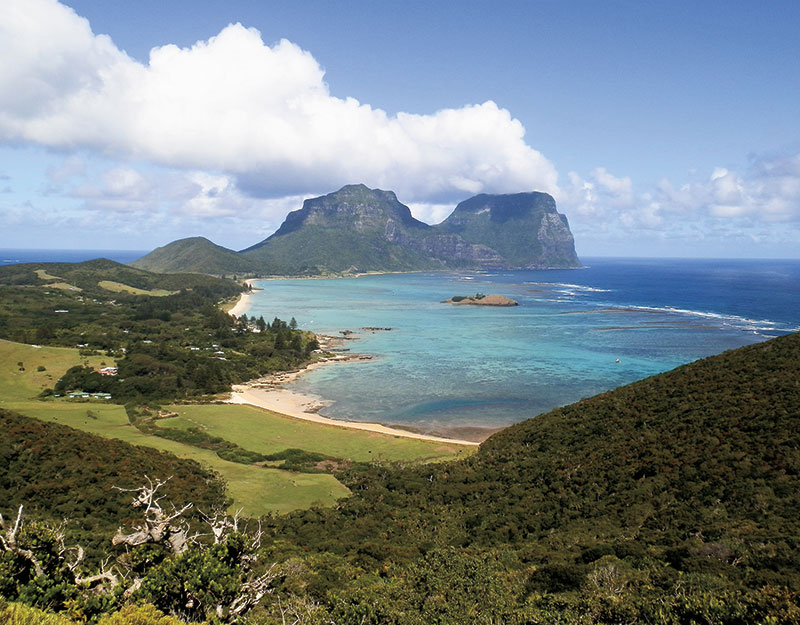
In 1982 the whole Lord Howe Island group, 27 islands with a combined landmass of only 1,455 hectares (3,600 acres) and the surrounding marine environment, was granted World Heritage status for its beauty and biodiversity.
And when the most famous living naturalist on the planet, Sir David Attenborough, describes it as “so extraordinary it is almost unbelievable”’, you know it’s going to be amazing.
So I expected the staggering scenery, fantastic natural attractions, various outdoor activities and laid-back islander lifestyle.
I was really looking forward to checking a few world exclusives off my list, and it is not that difficult on Lord Howe Island. I scored world exclusive #1 right after we left the terminal with our accommodation host for a quick familiarisation tour of the island, and drove past the 9-hole golf course. Not only is it perfectly picturesque, it’s the only golf course anywhere on World Heritage turf.
As our tour continued, I couldn’t fail to see world exclusive #2 which grew wild almost everywhere we went. The Kentia palm (Howea forsteriana), known and loved by gardeners and indoor plant enthusiasts around the world for its ability to survive outside the tropics, is one of several plants endemic to Lord Howe.
After the introductory tour, the luxury of car transport ended. For the rest of our stay we’d be either walking or cycling, as the 380 residents and the 400 tourists on Lord Howe at any given time generally do. But that’s no hardship on an island only 10 km (6.2 miles) long, between 0.3 to 2 km (0.19 to 1.24 miles) wide and with only a few kilometres of road. Besides, who ever said they’d rather go home from their holiday fatter and less fit?
I checked off world exclusive #3 just by standing on the balcony admiring the view of the two mountains. The rustling noise in the undergrowth turned out to be three Lord Howe Woodhens: around 1% of the total world Woodhen population, and one of the rarest birds on earth. Once thought to be extinct, a few breeding pairs were found on Mount Gower’s summit in the 1970’s, and after a successful breeding program they were reintroduced to the rest of the island, the only place in the world they’re found.

Road signs warning travellers of Lord Howe Woodhen crossings don’t appear anywhere else in the world either, but it’d probably be cheating to count these as a separate world exclusive!
The island is the tip of a drowned volcano rising from the sea bed two kilometres below (yes, that’s where those peaks came from) on the ‘Lord Howe Rise’ undersea plateau, putting it in an unusual geological position. The mixture of cool, deep sea trench seawater with warm currents from mainland Australia creates a mild, humid climate where flora and fauna habitats have developed outside their normal range.
It’s pretty good for tourists, too!
So we discovered the astonishing beauty of the dense rainforests, soaring cliffs, rocky coves, pandanus wetlands, offshore islands, rolling hills, jagged peaks, banyan trees, beaches, reefs, mist forests, rugged coastlines, hidden valleys, sensational views, wonderful wildlife and clear waters.
The days passed quickly as we hiked the network of walking trails criss-crossing the island, did some of the water-based activities and ate our way around the island, while the world exclusives just kept on coming.
I found #4 at the end of the road south to Little Island, the only remaining Providence Petrel breeding grounds in the world. Named in 1790 by grateful Norfolk Islanders who ate the entire petrel population when their supply ship sank, thousands are now regularly seen flying around the cliffs above Little Island during breeding season from February to October.

Little Island is also starting point for the guided 14 km (8.7 miles) nine-hour return hike to the 875 metre (2,870 ft) Mount Gower summit. Although the scenery is undoubtedly stupendous, I got vertigo just looking at the steep, exposed ridge leading to the top and the thought of circling around the exposed cliff edge beyond Little Island gave me the cold shivers. So I stuck to the lesser walks while continuing my world’s-slowest-cyclist demonstrations instead.
On Mt Lidgbird’s formidable cliffs where the petrels nest is world exclusive #5, the world’s largest natural rock cross, or so I was told by a local. Unable to find any evidence to confirm or refute this claim, I’m claiming the exclusive until I’m proven wrong.
The glass-bottomed boat tour to North Bay took me across the world’s southernmost large reef for exclusive #6. We climbed Mount Eliza for spectacular views back to those mountains at the other end of the island, then returned via a steep but scenic walking trail to Old Settlement Beach and the jetty, where most of the island’s supplies are shipped in.

After swimming, snorkelling and feeding some of the island’s 500 recorded fish species at Neds Beach, we took the 45-minute climb up Malabar Hill, 208 metres (682 ft) above the beach and offshore Admiralty Islands. That’s where I found exclusive #7: the world’s greatest breeding concentration of the Red-tailed Tropicbird, one of the few birds on earth able to fly backwards.
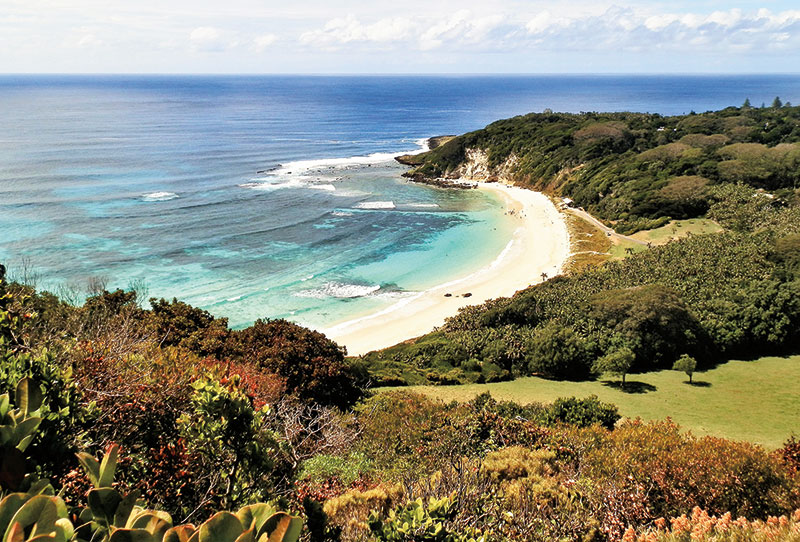
From Malabar Hill I first saw Ball’s Pyramid. At 552 metres (1,811 feet) it’s the world’s highest volcanic rock stack, and world exclusive #8. Following Bryden Allen’s first successful ascent in 1965, Balls Pyramid was scaled in 1979 by explorer and entrepreneur Dick Smith who claimed it for Australia. These days, landing on the islet without special permission isn’t possible, but it is possible to sail around it, weather permitting. It’s also on the Lord Howe Rise, but is separated from Lord Howe Island by 23 km (14.2 miles) of open sea and a 2,000 metre (6,561 feet) deep sea trench, so motion sickness sufferers beware!
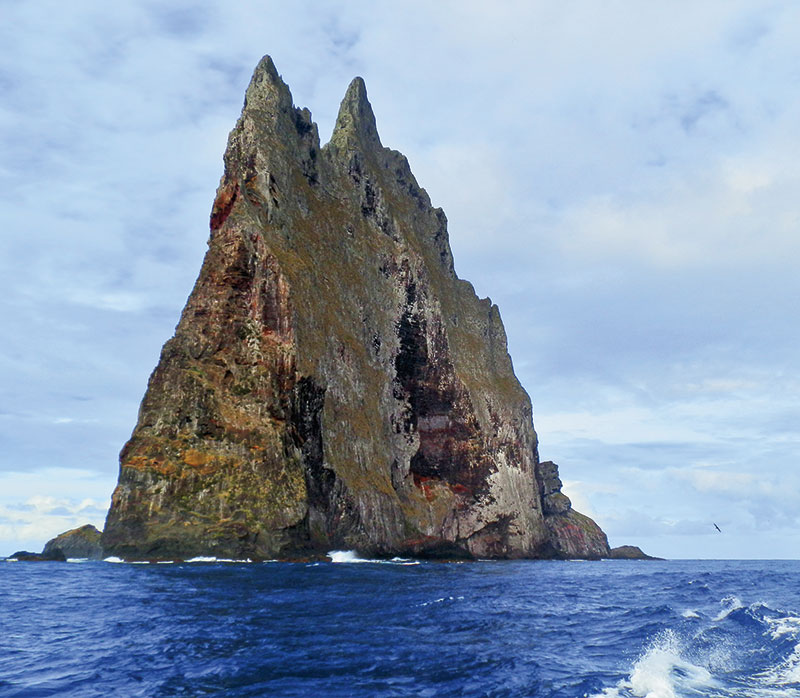
Although poor weather thwarted our first two attempts to see the pyramid up close, the third time was the charm. The wait was worth it, as our four-hour boat tour took us under the soaring cliffs so we could experience its stupendous size. Luckily the rough seas and continually lurching boat didn’t affect my cast iron stomach, and for my money, this is Australia’s best day tour.
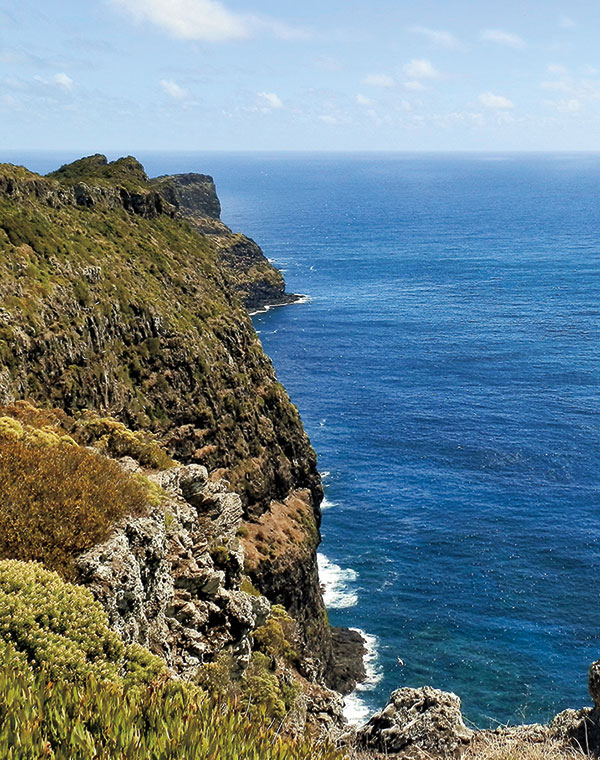
Ball’s Pyramid is also responsible for the survival of world exclusive #9: the Lord Howe Island Phasmid, or land lobster, which I got to see at the Visitor Centre and Museum. Thought to be extinct, it was re-discovered on the pyramid in 2001 and is now undergoing a breeding program before reintroduction to Lord Howe Island.
Being an incurable dunny detective, convenience chaser and loo lover, finding exclusive #10 was easy. But it’s up to you to decide if I’m right about whether or not the fantastic view from the Lagoon’s public amenities block makes this one of the most scenic loos anywhere!

Then it was time to leave and the plane was booked solid. With those deadly crosswinds and that 900 metre (2,952 feet) runway, about six times shorter than a standard airstrip, the plane needed all the help it could get to clear the runway and then clear the ocean beyond. So in order to ensure the plane didn’t exceed its maximum take-off weight, all passengers were weighed as well.
“I’ll take off 10 kilos for your red hair”, the baggage handler offered with a laugh as I stepped onto the scales. It wasn’t really necessary after all that exercise and fresh air, but I guessed he was joking.
“I’ll stay behind so you can fit all the luggage on”, I retorted, in a kind (read: desperate) counter-offer!
Tragically, for some unknown reason my sacrifice wasn’t accepted, so we sadly stepped aboard the plane.
But I know I’ll be back in paradise some day.
And for a few magic moments, Australia’s wildest river was the most civilised place on earth.

FOLLOW MARION HALLIDAY:
Marion blogs as “Australia by Red Nomad OZ” at www.redzaustralia.com.
▷
Follow Marion @rednomadoz on Twitter, Pinterest, Linked, and Flickr. Facebook: RedzAustralia.
▷
Buy her book: “Aussie Loos with Views!” at Amazon.com, eBay and at www.exploreaustralia.net.au
☛ Read more: Cruising with Crocodiles in Australia’s Top End


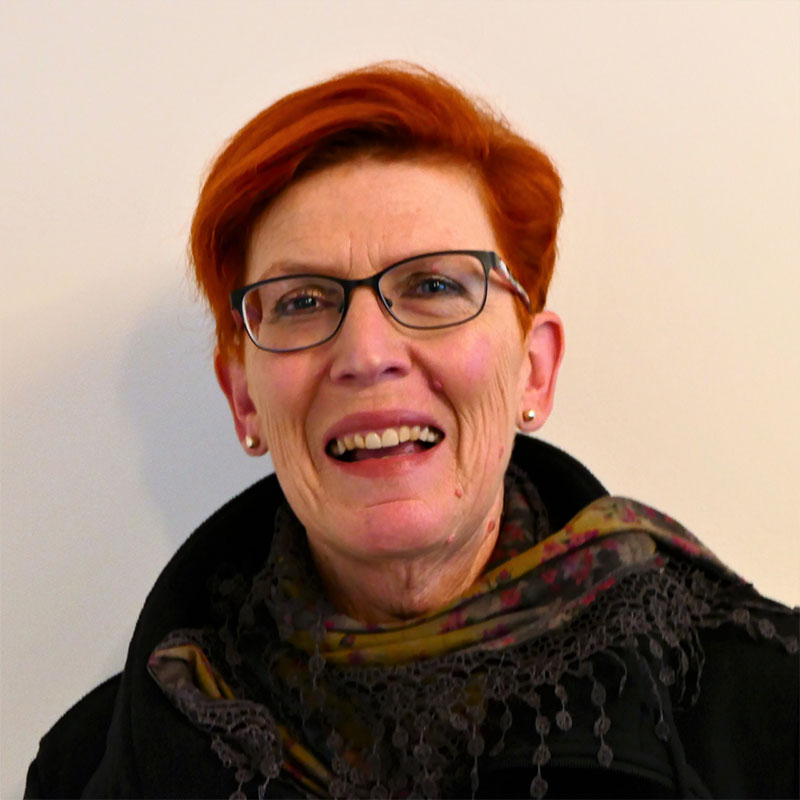
Marion is “Red Nomad OZ”, author, blogger and Aussie traveller who loves discovering nature-based attractions and activities – and scenic loos – all over Australia. Her Aussie travel blog and published book “Aussie Loos with Views” provide inspiration for other Aussie explorers.
